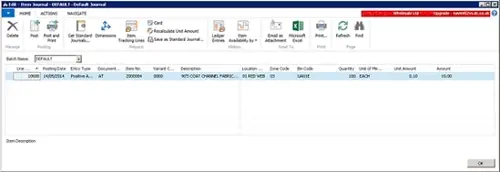What’s New in Business Central 2025 Release Wave 2
The Autumn brings the second major release of the year for Business Central, as part of the 2 wave annual update cycle. Here we look at the highlight features.

A complaint that I often get from Microsoft Dynamics® NAV users who have implemented the full ‘Directed Pick & Put-away’ warehouse functionality is that if you want to adjust stock you have to enter a Warehouse Item Journal, Register it, and then go to an Item Journal ‘Calculate Warehouse Adjustments’ and then Post. A similar task has to be undertaken for Physical Inventory Journals, Whereas Reclassification Journals are completely blocked.
When I was first trained in NAV warehousing, the trainer, who was directly employed by the old Navision Company said that the reason that it was developed that way was so that the Warehouse could adjust stock, and effectively make it un-pickable, without affecting the balance sheet, with the second transaction being undertaken by the accountant at a later date.
In principle this sounds like a good idea, but the way the functionality has been designed means that in the period between Registering the Warehouse Item Journal and Posting the Item Journal you end up with an imbalance between Warehouse Bin Contents and Inventory, which is totally invisible to SOP, POP and MRP. As a result you think you have stock that does not in fact exist! You also cannot move stock between ‘Directed Pick and Put-away’ Locations without a Transfer Order.
As a result of the above issue, the usual practice is to always do both the transactions together. This takes away any advantage of the original design concept of splitting the process into two steps. The danger with this practice is that if a user forgets to undertake the second step, or an Item Journal Line is posted directly (both of which actually do happen), you end up with stock imbalances between the Warehouse and Inventory, which inevitably brings NAV into disrepute.
When later on, Microsoft added the simpler ‘Bin Mandatory’ functionality into NAV it became possible to specify a Bin Code on Item, Physical Inventory, and Reclassification Journals directly. However, ‘Directed Pick & Put-away’ Locations with a Zone code were explicitly excluded. This means that most of the code for writing the Warehouse Entries necessary to accommodate Bins is already present.

Here at Dynamics Consultants, we like to offer minor changes to our customers that can significantly improve the usability of Microsoft Dynamics NAV. As a result, we have developed “Zone Enabled Item Journals”!

If you would like some further information on our bespoke warehousing solutions, or any bespoke development information, please do feel free to contact us.
This is just a small example of what we can do for our customers, and prospectively... you, to make day-to-day business less time consuming... more streamlined and Dynamic!
Want to see more?
Then subscribe to our mailer and we will email you with updates regarding what we do & more importantly, what we can do for you!
There are many more 'Wisdom-Filled' blog articles on our website, please don't hesitate to check them out!
Select one of the links below and don't forget to leave a comment.
SharePoint List Personal Views
Offline File Sync for Microsoft SharePoint using SkyDrive Pro
SharePoint 2013 Outlook Calendar Integration
Best Regards,
The Dynamics Consultants Team.
The Autumn brings the second major release of the year for Business Central, as part of the 2 wave annual update cycle. Here we look at the highlight features.
After a recent visit to the Digital Manufacturing 2day event in Coventry and an insightful presentation by Lord Chris Holmes, I thought I would delve a bit deeper into the current AI regulation facing UK industry.
Choosing the right ERP system when moving on from Sage 50 can shape how efficiently your business grows and adapts. If you want advanced features, greater flexibility and easier integration with familiar Microsoft tools, Microsoft Dynamics 365 Business Central is often the stronger option compared to Sage 200. As real-time data insight, automation and scalability are now necessities and not luxuries, your ERP upgrade decision is more important than ever.